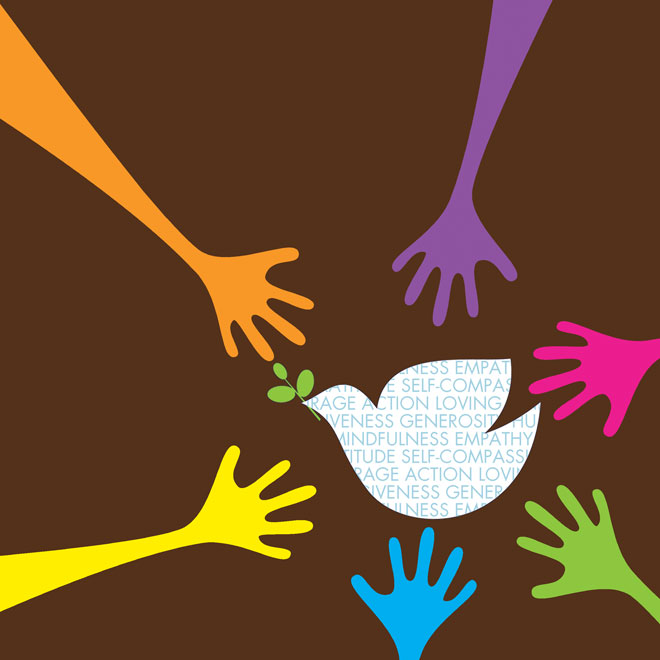 Children are often told in a tone of reprimand by parents and teachers: “How would you feel if they did that to you?” It is essentially the photo negative of the Golden Rule (“do unto others …”). What if that message evolved into a positive set of values, then fused into lesson plans, group activities and a school ethos?
Children are often told in a tone of reprimand by parents and teachers: “How would you feel if they did that to you?” It is essentially the photo negative of the Golden Rule (“do unto others …”). What if that message evolved into a positive set of values, then fused into lesson plans, group activities and a school ethos?
It’s happening all over the world, thanks in part to the efforts of the Charter for Compassion and its partners.
The Charter for Compassion is a call to restore the Golden Rule to the center of religious, moral and civic life through listening, understanding and treating all others as we wish to be treated ourselves. Not simply a statement of principle, the charter is a summons to take creative, practical and sustained action to create a just economy and a peaceful world.
Drafted in 2009 by a multifaith, multinational council of thinkers, leaders and citizens as part of author Karen Armstrong’s TED Prize wish, the charter has been affirmed by more than 89,000 individuals, communities, cities and schools.
Compassion is more than simply a nice idea, says Armstrong, author of Twelve Steps to a Compassionate Life and 2008 TED Prize winner. “Compassion is not an option — it’s key to our survival.”
The TED Prize was born out of the TED (Technology, Entertainment, Design) Conference and a vision by the world’s leading entrepreneurs, innovators and entertainers to change the world — one wish at a time. From U2 front man Bono’s ONE Campaign (2005 recipient) to chef Jamie Oliver’s Food Revolution, the TED Prize tackles poverty and religious intolerance, and aspires to improve global health and advance education.
Through the Charter for Compassion and the work of more than 100 partner organizations, the charter has gone from a document of principle to a basis for developing practical programs for implementing compassion. The International Campaign for Compassionate Cities (now Compassion Action Network International) was one of the initiatives inspired by the Charter for Compassion and the 2008 Seeds of Compassion event in Seattle.
Seattle was the first city to undertake the charter’s goals. In 2008, Seattle hosted the Seeds of Compassion event with the Dalai Lama, and in 2010, the Seattle City Council declared Seattle to be the world’s first “Compassionate City.” As of today, more than 80 cities have joined the movement — from Gaziantep, Turkey, to Louisville, Kentucky.
The Charter for Compassion has also spawned a movement to create a worldwide network of compassionate schools. The first “official” compassionate school was named in London, Ontario, in 2011. Most cities working for compassionate city status include an education element in their 10-year plans.
The drive to bring compassion to schools has increased even faster than the city campaign. A number of programs were started not by adults, but by the children themselves. In Amman, Jordan, and Basalt, Colorado, middle school students created and sustained the concept; in Basalt, the kids made their case in front of the town council and convinced members to declare the town a compassionate city. Today, an education working group composed of education experts and practitioners from the U.S., Canada, Pakistan, the Netherlands, Jordan and the U.K. meet online regularly.
Of course, compassion isn’t the property of just one project. Some of the programs described below take the Charter for Compassion as a baseline; others do not. But all these endeavors are inspirational in the same way: They are dedicated to instilling compassion into our children and everyone they touch.
THE SCIENCE
This is your brain on compassion
The science of compassion is a growing field of academic research. Stanford University’s Center for the Study of Compassion and Altruism Research and Education (CCARE) recently hosted the first international symposium on compassion as scientific inquiry.
Scholars at CCARE and Emory, Northeastern and Berkeley universities report a number of findings: Compassionate feelings show up differently in brain activity; experiencing even one moment of compassion can affect behavior toward others; and compassionate thought patterns can be taught with a variety of techniques.
Recently, cognitively based compassion training has been shown to improve the mental and physical health of adolescents in foster care. CCARE’s Compassion Cultivation Training (CCT) — a nine-week course designed to develop the qualities of compassion — is used to treat post-traumatic stress disorder (PTSD) in soldiers returning from war.
So effective are these practices that Stanford’s CCARE is now offering certification in the training starting this fall.
That’s right. Your brain can be trained to be more compassionate. What’s even better is that numerous studies show that the parts of the brain activated by compassion are the very same ones that lead to feelings of pleasure, elevation, and to greater physical health and longevity.
Northeastern professor David DeSteno noted in The New York Times just how devastating simple spawning compassion can be: “Increased compassion for one’s neighbor, for instance, can come from something as easy as encouraging yourself to think of him as a fan of the same local restaurant instead of as a member of a different ethnicity.…Simply learning to mentally recategorize one another in terms of commonalities would generate greater empathy among all of us — and foster social harmony in a fairly effortless way.”
Are we inherently selfish or social?
It is not uncommon to think of children as existing in a purer state of nature than adults, with our social norms and lifetimes worth of issues. Quarreling heads of state are often depicted as angry toddlers in a sandbox in political cartoons.
But recent scientific writing maintains that humans may be born with a propensity toward compassion. The father of sociobiology, E.O. Wilson, suggests that after a certain point of evolution, the selfish gene loses out to those altruistic genes that foster cooperation among social groups. Another example of the benefits of behaving compassionately: Scholar Michael Norton contends in a recent TED talk that brain studies show that money can actually buy happiness. That is, if you spend it on someone else.
THE TECHNIQUES
So, what to do with all this new knowledge? Bullying has moved up on parents’ and teachers’ agendas this year, particularly after producers fought the R rating that the documentary The Bully Project initially received (it was ultimately rated PG), and when a YouTube video of a bus monitor being bullied went viral. Many people are left wondering how to foster compassion and positive social behavior among all age groups.
The key: Acknowledging that compassion is a skill that can and should be taught in every classroom. Techniques range from full-fledged cognitive training to instituting daily practices of respect.
Begin with the babies
Recent scientific studies indicate that even babies reap some emotional benefit from helping others. And babies play a teaching role in the Roots of Empathy program, started by educator Mary Gordon in 1996 and now practiced around the globe. In Seattle, the program is offered in conjunction with the Puget Sound Educational Service District.
The program brings a baby and parent into the classroom for visits over a period of a year. The children learn to observe the baby and interpret its needs and emotions. They are then encouraged to give the same caring attention to their class and their world.
Roots of Empathy has a strong track record. A number of measurable results show an increase in social and emotional competence and empathy, and a reduction in aggression. The Institute for Learning and Brain Sciences at the University of Washington is in the midst of a study to evaluate brain and behavioral development in 5-year-olds in the Seeds of Empathy program and 9-year-olds in the Roots of Empathy program.
Use the art of compassion
Being able to visualize life through another’s eyes is a key element in building empathy — and there’s no better place for visualization and imagination than in a school art class. One spectacular example took place last year in Appleton, Wisconsin. All the students in the district — more than 10,000 — were asked to create art on the subject of compassion. The resulting exhibit filled the local Appleton Museum and is permanently hosted online. The visual and verbal results are well worth a visit.
Check it out:
“To me compassion means to cherish, love, or care or help someone or something. My image represents compassion because it is a hand surrounded by pictures of nature to represent being compassionate about our earth and helping it out.” Aaliyah Hernandez
“Compassion can have a rippling effect for all of us. If you show compassion to one person, it has the potential to encourage them to be compassionate to another. The idea of being kind and compassionate spread and spreads to many different people. The mandala I created represents the idea of a rippling effect.” Katherine Vandervelden
“My picture shows some giving food to the less fortunate. In the background is the world, and we should do this for the less fortunate in the world.” Andrew Parker
 R-e-s-p-e-c-t
R-e-s-p-e-c-t
Change can begin with a simple modification of daily routine. At Brooklyn’s High School of Telecommunication Arts and Technology, every teacher and student is required to use each other’s name in conversation and debate.
“Kindness is the operating order for our school,” says assistant principal Jeffrey Osler. “All interaction should reflect that. When you use a person’s name, it shows respect to them and their ideas, no matter the context.”
Education expert Molly Barker created an easy tool for younger kids to learn about empathy and compassion: Simply take a few pairs of shoes and label them. “Poor,” “rich,” “boy,” “girl,” “homeless,” “physically disabled,” “old,” “young,” “sick,” “from a different country,” “different religion,” “different ethnicity,” and “different political beliefs.” She then asks the child to “walk” in another person’s shoes.
THE PROGRAMS
The Compassionate School Network
The Charter for Compassion programs in Pakistan and Jordan have teamed up as the Compassionate School Network to develop a complete compassionate school curriculum. The program is based on the belief that “compassion is a skill” that can be learned and cultivated. The program introduces 10 compassion skills: generosity, humility, mindfulness, empathy, gratitude, self-compassion, courage, action, loving kindness and forgiveness.
The program is under way in 10 schools in Karachi. Organizers hope to increase the number of schools and expand to other countries. “We are inspired by the Charter for Compassion and truly believe that compassion can be learned — but that requires daily, conscious practice,” says Meg Lyons, the program’s administrator.
The group’s website hosts dozens of sample lessons and will soon provide an online venue for teachers across the globe to share tactics and ideas.
Teens talking
Another multinational collaboration on compassionate education focuses on teens and those who work with them. Mind with Heart, a British-based education group, offers events, teacher training and online ventures such as Is It Crazy, a blog that asks, “Is it crazy to think I can be kind and successful?”
Mind with Heart in London will host an international convention on “Empathy and Compassion in Society” in November. Presenters will introduce the latest scientific research on empathy, top leaders in the field (including Karen Armstrong and Mary Gordon) will speak, and more than 300 teens from around London will attend.
The Northwest’s own
The Pacific Northwest is on its way to becoming a hotbed of compassionate education. The Vancouver School Board offers a complete compassion curriculum for grade school through secondary school.
Lessons range from a high school science lesson on water systems, which asks, “How do our choices have environmental and human consequences?” to elementary school exercises on the importance of memory to children and adults. And now, a program cosponsored by the Dalai Lama Center for Peace and Education is rolling out compassion education for kids and training for teachers across the province.
The Youth Ambassador Program, headed by Lori Markowitz, grew out of Seattle’s 2008 Seeds of Compassion event. Markowitz creates programs based on her belief that “we don’t empower young people enough to be part of the solution.”
Over the past three years, her compassion awareness program for teens has evolved into a new venture. Last year, Markowitz was asked by the county court system to come up with a way for her ambassadors to combat truancy (and help teens avoid truancy court) in Seattle’s low-performing schools. One of her teen-to-teen mentoring programs proved so successful that the school is now offering it as an education course for credit.
“Is it going to fix everyone, and is everyone going to be a great mentor and go back to school? No. But will it do a lot of good? Yes,” says Markowitz. “Now the state of Washington is looking at this class to see if it can be replicated around the state. And I’ve seen what it can do; it changes the environment in the schools.”
Ashoka is a worldwide association of social entrepreneurs that has been in the field of encouraging social entrepreneurship among ordinary citizens for 30 years. Now it is turning its attention to problem-solving by cultivating empathy in American schools.
Ashoka’s Start Empathy program, created in tandem with The Bully Project, is the next big thing in compassionate education.
The organization, which works to inspire leaders and “changemakers” to create positive social change, has created a digital home for parents, educators, students and others interested in compassionate education.
So connect with other schools, find anti-bullying tools and explore the latest compassion science. If this is the future of collaboration in the realm of compassionate education, embrace it. It’s a great start.
Kristin Miller is a multimedia journalist and the editor of The Charter for Compassion website. She won the Edward R. Murrow and Gracie Allen awards, and holds two master’s degrees in history from Columbia University.
Resources
The Charter for Compassion is a document that transcends religious, ideological, and national differences.
- Supported by leading thinkers from many traditions, the Charter for Compassion activates the Golden Rule around the world
- View Armstrong’s 2008 TED Prize talk and explore the history of the movement here.
- Start Empathy provides lesson plans, analysis of news, how-to’s, videos and active blogs. It’s an initiative of Ashoka.
- Vancouver BC’s Dalai Lama Center for Peace and Educationpresents a wealth of material for seekers of all ages. The fall marks the start of a new program “Educating the Heart” bringing mindfulness and compassion to youth all over the province.
- The Dalai Lama Center works with the Vancouver School Board which has a wide curriculum developed for compassion education. Vancouver’s programs include lesson plans for all class levels and emphasize the intergenerational aspect of compassion. Their work is a great model for communities starting out.
- Seeds of Compassion in 2008 brought The Dalai Lama and the Charter for Compassion to Seattle — and the Compassionate City designation to the city. Its collection of education materials is still vital.
- CFC Pakistan: Compassionate Schools Network. This site for the network of schools in Pakistan and Jordan is a rich resource for teachers, administrators and parents. As the year progresses, CSN will add video of teacher-training sessions, more complete lesson plans and a blog where educators can exchange ideas. There’s also a safe space for students in compassionate education program to meet online. Stage one is underway with children from Basalt, Colorado and two schools in Lahore, Pakistan.
- Britain’s Mind with Heart works with teens and offers training for teachers. Don’t miss their wonderful series of teens talking with “the happiest man on earth” and social psychology experts on YouTube.
- The Canadian group who initiated the Children’s Charter for Compassion offers activity books for the younger set.
- The State of Washington has created a handbook called The Heart of Learning and Teaching for starting and nourishing a compassionate school. This material is mainly geared for teachers and others work with children who have experienced trauma.
- The documentary The Bully Project provides viewing guides, for parents, teachers and students as well as a toolkit for using the film with special needs students.
- For those interested in instilling compassion into their daily lives — join the Twelve Steps to a Compassionate Life Book Group on Facebook.
Other web sites:
- Roots of Empathy
- Stanford University’s Center for the Study of Compassion and Altruism Research and Education (CCARE)
- Compassionate Seattle
- Mind with Heart convention on Empathy and Compassion in Society
- The Institute for Learning and Brain Sciences at the University of Washington
- Community of Mindful Parents
- Listening Mothers
- For a list of Roots of Empathy programs in Puget Sound schools, go here









